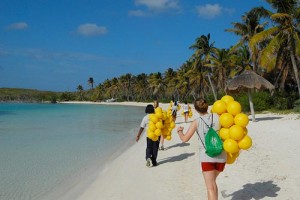Alternative break program grows to meet interest
After USC expanded its alternative spring break program this year, the program received 161 applicants by its deadline at 5 p.m. Tuesday.
The alternative spring break program added three more trips this year after student participation in the program increased in the past few years.
The alternative winter break program received 66 applications.

Spring break · USC students traveled to Isla Mujeres, Mexico last March as part of an alternative spring break program. The program received 166 applicants this year. - Photo courtesy of Joenique Rose
Alternative spring break program added trips to Honduras, one to West Virginia and one to a mystery location this year, bringing the total number of programs to seven domestic and three international trips.
The program offers students the opportunity to participate and coordinate different trips to volunteer for a variety of causes.
“One of my goals is to be able to offer more opportunities for students to go on these trips because we do get an abundance of applications,” said Joenique Rose, program manager for Alternative Breaks and Community Partners.
Rose said the Honduras trip was added earlier this year after a nonprofit organization approached her. Ten students will visit a small community to help coffee farmers.
“The idea is for students [to work] and [see] where the coffee farmers pick their coffee cherries, [help] them lay down foundations in some of their homes because a lot of them have dirt floors and [lay] some water pipes down for a well,” Rose said.
The program will give students opportunities to work with the village community and learn about the coffee industry.
“Students will be going into classrooms and doing English lessons,” Rose said. “They will be helping the whole family in their day to day life and see what this occupation does for their family.”
Ryan Rysyk, a senior majoring in psychology who has coordinated and participated in programs in previous years, said at first he participated in the program to visit a new location but ended up learning about the health system in Baltimore, Md.
“My freshman year I did not know much about [alternative breaks],” he said. “I was interested in seeing Baltimore when I first went, but it gave me the opportunity to actually see what was going on there.”
Students who go on the West Virginia trip will volunteer in the Appalachian region.
The program also debuted a new type of trip, in which students sign up without knowing where they will be sent. The trip will relate to juvenile justice and will be domestic.
“We have people apply out of interest rather than locations to see how many people are receptive,” Rysyk said. “It’s really the word of mouth from students who have participated and tell their friends that increases the number of people who apply every year.”
The alternative break program also reinstated a winter trip to Thailand, which was canceled two years ago because of security issues in the country.
The winter trip to Thailand started in 2005, in response to the 2004 tsunami, and was the first alternative winter break the Volunteer Center facilitated.
This year Lindsey Poole, a junior majoring in communication, will coordinate the trip to Thailand. She said she has received 70 applications for the trip.
She previously went on an alternative winter break trip to Belize.
“It was a great experience to step out of my comfort zone and get to know other Trojans that I would’ve not met otherwise,” Poole said. “It just gave me a greater insight to different people and how their lifestyles are so different depending on their culture. I left with a broader perspective.”
Jessie Friedmann, a sophomore majoring in policy, planning and development, is coordinating a trip for the first time this year.
Her group will be going to Orcas Island in Washington, where it will clean up streams and deal with other pertinent environmental issues.
Friedmann said some students would rather relax than volunteer during spring break.
“Spring break, you want to relax and go somewhere sunny,” Friedmann said. “Probably the idea of going to Seattle where it’s 50 degrees and raining isn’t their first choice.”
Friedmann said, however, alternative break programs are rewarding enough to be worth it.
“All of them take you out of Los Angeles and when you’re at USC you’re in a bubble,” she said. “[It’s] getting a perspective out of USC and dealing with issues you don’t see at USC and bringing back that experience.”

Ellen, I am in total support of your lifestyle choices. No judgements from me or my bros!
and you Fratboy5, may need to learn how to spell ‘capital”, your spelling is of another context usage of the word that is incorrect. So when you made snide comments, your misspelling will surely show the source as not the brightest.
I just read that Honduras is the murder capitol of the World. Be sure and bring lots of sunscreen.